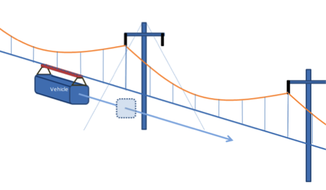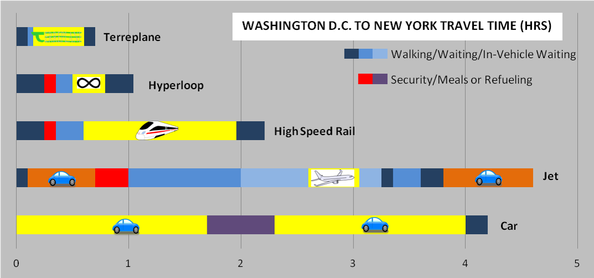These will be achieved because the TERREPLANE system embraces nature as opposed to working against nature. Key elements of the system that make these possible are: the Land-Based Glider approach, the Guide Way, direct use of Grid Electricity as the power source, and Efficiency.
Land-Based Glider - Conventional land-based vehicles like cars and trucks direct the air impacting the front of the vehicle over the top of the vehicle. In fact, this is critical for race cars to prevent them from becoming airborne. Conventional land-based vehicles are designed to fight the impact momentum of the air that hits the front of the vehicle. TERREPLANE vehicles use that impacting momentum to fly like a glider. The glider aspect is important to eliminate the weight of the engine and fuel from the vehicle and allow the vehicle to fly like a glider WITHOUT HAVING ANY OBVIOUS WINGS?
|
Guideway - Since both the TERREPLANE vehicle and Propulsion Carriage fly, they have no vertical or lateral forces on the propulsion line--there is primarily a "pulling" force on the Propulsion Line that advantageously straightens the line making high speed travel possible with inexpensive designs. Unlike highways or railroads, TERREPLANE does not tear into nature's hills and meadows. TERREPLANE does not use roads or railway lines. The figure to the right illustrates how TERREPLANE can be implemented as a series of posts, 4-5 posts per mile, that provide both electrical power transmission and the TERREPLANE guideway. The environmental impact is much less than alternatives.
|
Click to Enlarge
|
Grid Electricity - By using grid electricity, there are many good options to reduce greenhouse gas emissions and reliance on foreign petroleum. TERREPLANE can be powered by new generations of safe and inexpensive nuclear power.
Efficiency - Direct us of electricity rather than use of batteries is about 25% more energy efficient than use of batteries. Use linear motors can approach the high efficiency that is used in electric motors and electrical transformers. There is essentially nothing having a greater potential for energy efficiency.
1/5th the Time (more on the topic)
The following chart summarizes how Terreplane can attain total transit times of less than 20% of air transit and cars. The excellent performance stems from: a) highly accessible terminals due to use of the same system for commuter and trans-continental transit, b) non-stop service due to inexpensive guideways and high-speed switching, and c) high speed transit.
TERREPLANE is a societal-transforming technology. It is faster than alternatives due to its high speed (500 mph for open-air systems) and its ability to network local commuter lines with inter-city lines. While slower than Hyperloop, total travel times tend to be less. Example travel times are:
42 minutes - New York - Washington D.C. (destination to destination, including walking time)
1:06 hr:min - San Francisco to LA
25-45 min. - Most locations in New York to most locations in Philadelphia
TERREPLANE vehicles will not have prominent wings. They will have "flaps" that are used for control and fine tuning of lift, but TERREPLANE vehicles will not have obvious wings unless they are designed for novel applications.
42 minutes - New York - Washington D.C. (destination to destination, including walking time)
1:06 hr:min - San Francisco to LA
25-45 min. - Most locations in New York to most locations in Philadelphia
TERREPLANE vehicles will not have prominent wings. They will have "flaps" that are used for control and fine tuning of lift, but TERREPLANE vehicles will not have obvious wings unless they are designed for novel applications.
1/5th the Energy (more on the topic)
During normal operation, the energy expended to operate Terreplane is the energy to overcome drag, where:
ENERGY = Weight / [Lift:Drag ratio]
1) Reducing Specific Weight: At the same L:D ratios as jet aircraft (about 18:1), Terreplane is able to attain 50% the specific weight of airliners due to elimination of fuel (use of grid electricity) and elimination of aircraft components like the cockpit, wing structures, landing gear, and redundant control hardware.
2) Increasing Fuel Efficiency: Another 44% reduction in fuel consumption is attributed to electrical power generation which is more efficient than the combustion engines of jet and propeller aircraft.
3) Reduced Distances and Less Waste: Finally, another 30% reduction is attributed to less energy expended going to the airport, non-stop transit rather than use of connecting flights, autonomous operation eliminating mass of pilots and flight attendants, and elimination of "hold patterns" in the queue for landing.
In total, there is an 80% reduction in energy resulting in a fuel economy of about 250 passenger-miles per GGE.
The 400% increase in fuel economy in unprecedented in history and should be applicable to several major transit corridors. Other corridors may have a mere 300% or 200% increase in fuel economy.
During normal operation, the energy expended to operate Terreplane is the energy to overcome drag, where:
ENERGY = Weight / [Lift:Drag ratio]
1) Reducing Specific Weight: At the same L:D ratios as jet aircraft (about 18:1), Terreplane is able to attain 50% the specific weight of airliners due to elimination of fuel (use of grid electricity) and elimination of aircraft components like the cockpit, wing structures, landing gear, and redundant control hardware.
2) Increasing Fuel Efficiency: Another 44% reduction in fuel consumption is attributed to electrical power generation which is more efficient than the combustion engines of jet and propeller aircraft.
3) Reduced Distances and Less Waste: Finally, another 30% reduction is attributed to less energy expended going to the airport, non-stop transit rather than use of connecting flights, autonomous operation eliminating mass of pilots and flight attendants, and elimination of "hold patterns" in the queue for landing.
In total, there is an 80% reduction in energy resulting in a fuel economy of about 250 passenger-miles per GGE.
The 400% increase in fuel economy in unprecedented in history and should be applicable to several major transit corridors. Other corridors may have a mere 300% or 200% increase in fuel economy.
1/5th the Cost (more on the topic)
Reductions in costs are annualized costs, with similar 80% reductions in capital, maintenance, and operating costs. The primary reason for the lower capital and maintenance costs are the inexpensive zipline-type guideways. The primary reason for lower operating costs are improved fuel economy and short transit times that allow rapid turnover of the vehicles.
Reductions in costs are annualized costs, with similar 80% reductions in capital, maintenance, and operating costs. The primary reason for the lower capital and maintenance costs are the inexpensive zipline-type guideways. The primary reason for lower operating costs are improved fuel economy and short transit times that allow rapid turnover of the vehicles.
Range of Vehicle Options
The below table summarizes example TERREPLANE vehicles including the two benchmark cases of the Wright Brothers first aircraft and a Cessna 150. The wingspan of the Cessna 150 is 33 feet, and simple calculations will illustrate how the "prominent" wing aspect of this vehicle disappears as the weight of the vehicle decreases and the velocities increase. The assumptions are that lift (including impact momentum) are proportional to the velocity squared and that the body of the vehicle contributes to 20% of the lift.
By reducing the weight of an aircraft by 50% through removing the engine and fuel, the needed wingspan is decreased from 33 feet to 14 feet. A doubling of the velocity would further decrease the needed lift to 25% of the lift for the 63 mph takeoff velocity with a wing span of 3.7 feet. Hence, at about 75 mph, a 2-seater TERREPLANE vehicle would not need obvious wings. The addition of a spoiler would allow an 8-seater to fly at 90 mph.
The below table summarizes example TERREPLANE vehicles including the two benchmark cases of the Wright Brothers first aircraft and a Cessna 150. The wingspan of the Cessna 150 is 33 feet, and simple calculations will illustrate how the "prominent" wing aspect of this vehicle disappears as the weight of the vehicle decreases and the velocities increase. The assumptions are that lift (including impact momentum) are proportional to the velocity squared and that the body of the vehicle contributes to 20% of the lift.
By reducing the weight of an aircraft by 50% through removing the engine and fuel, the needed wingspan is decreased from 33 feet to 14 feet. A doubling of the velocity would further decrease the needed lift to 25% of the lift for the 63 mph takeoff velocity with a wing span of 3.7 feet. Hence, at about 75 mph, a 2-seater TERREPLANE vehicle would not need obvious wings. The addition of a spoiler would allow an 8-seater to fly at 90 mph.

Here is a prototype design for the 24-passenger TERREPLANE Liner. Terreplane will set new standards in convenience and the no-worries approach to travel, and it is capable of delivering all the luxuries available with current travel ... such as lounge cars, sleepers, diners. Imagine a personal/family sleeper car that is automatically routed to park in your reserved hotel room ... where you wake up the next day at the final destination, in your hotel room, .... (you name it). Imagine leaving your office/home/hotel 30 minutes before your trans-Atlantic flight departs ... with arrival 40 feet from the gate three minutes before the gate closes with "no worries".
Cell phone Apps will provide travel options (non-stop and personal vehicle vs ride share vs connecting with a train ...), arrival time alternatives, and price alternatives. Commuter vehicles can have all the essentials of an office, so that a 400 mile commute which takes an hour to complete is both productive and easy to take.
The back-of-the-envelope calculations are just the starting point for what is possible. Great things are indeed possible. In many applications it would be "cost optimal" to allow the Propulsion Line to support part of the vehicle weight during travel.
This is the starting point. Optimal pressures in Vactunnels, optimal fractions of the weight to be supported by the Propulsion Line, and novel approaches to create lift lead to an entire new technology specialty with years of great work to be performed.
Cell phone Apps will provide travel options (non-stop and personal vehicle vs ride share vs connecting with a train ...), arrival time alternatives, and price alternatives. Commuter vehicles can have all the essentials of an office, so that a 400 mile commute which takes an hour to complete is both productive and easy to take.
The back-of-the-envelope calculations are just the starting point for what is possible. Great things are indeed possible. In many applications it would be "cost optimal" to allow the Propulsion Line to support part of the vehicle weight during travel.
This is the starting point. Optimal pressures in Vactunnels, optimal fractions of the weight to be supported by the Propulsion Line, and novel approaches to create lift lead to an entire new technology specialty with years of great work to be performed.
Environmental Impact
EvENVIRONMENT:
The vast majority of people want to preserve natural environments and want to end global warming. But the costs for past, effective solutions have been high. At times, the solutions have been too single-issue and have ignored the bigger picture. The TERREPLANE System changes this. A transportation system with substantially reduced environmental impact is able to provide lower cost, faster, and superior service that produces jobs locally.
The TERREPLANE System is able to directly use grid electricity as a power source, overcoming inefficiencies associated with the charging and use of batteries. Being based on grid electricity, a diverse and versatile number of sources are available to provide power, including some of the most efficient and "green" sources available. The TERREPLANE System also uses less energy per passenger-mile and has an absolute minimal footprint on the terrain.
COMMERCIALIZATION:
The TERREPLANE System is a truly novel approach to transportation that has design features capable of overcoming paradigms that have held back the evolution of transportation.
PHASE I - The first phase of the commercialization of this technology has been the documenting of these advances in about a dozen patent applications.
PHASE II - It is anticipated that the next phase of commercialization will be a "piggyback" commuter line across a bridge (Alternatively, extend a public transit system across a river or body of water where costs of traditional bridge are very high). While new bridge construction costs about $400 million per mile, Terreplane can be placed on overhead structures of existing bridges for about 5% of the cost of building a new bridge and more than double the commuter capacity of that bridge. (Alternatively, a new terreplane bridge costs less than 10% of traditional bridges.) In this initial application, cities will literally save hundreds of millions of dollars by piggybacking a Terreplane commuter route on an existing bridge as opposed to building a new bridge.
PHASE III - The third phase of commercialization is the superport network provides commuter service in region and connects all ports to function as a single port. This would double ridership on local high speed train systems in a few years since it overcomes the major problem of access to train stations (It can take longer to get to/from the seat in the train than the high speed train ride.).
This would be in a new era for flight check-in and security being made available at a convenient downtown (and other) location(s) and the Terreplane takes passengers straight to the concourse in a secured (past security) vehicle. Cities with two or three airports/stations could connect all to function as one airport with less than 10 minute travel times between airports and from downtown location. An approach to put an end to the uncertainty of traffic and long lines at security gates.
PHASE IV - Evolve! Improve rail and air transit experiences while allowing low-cost extension of Terretrane lines to meet larger markets and provide faster service. Evolution includes use of transit pods, autonomous parcel delivery, higher speeds, and transit in low pressure tunnels at even higher speeds.
The vast majority of people want to preserve natural environments and want to end global warming. But the costs for past, effective solutions have been high. At times, the solutions have been too single-issue and have ignored the bigger picture. The TERREPLANE System changes this. A transportation system with substantially reduced environmental impact is able to provide lower cost, faster, and superior service that produces jobs locally.
The TERREPLANE System is able to directly use grid electricity as a power source, overcoming inefficiencies associated with the charging and use of batteries. Being based on grid electricity, a diverse and versatile number of sources are available to provide power, including some of the most efficient and "green" sources available. The TERREPLANE System also uses less energy per passenger-mile and has an absolute minimal footprint on the terrain.
COMMERCIALIZATION:
The TERREPLANE System is a truly novel approach to transportation that has design features capable of overcoming paradigms that have held back the evolution of transportation.
PHASE I - The first phase of the commercialization of this technology has been the documenting of these advances in about a dozen patent applications.
PHASE II - It is anticipated that the next phase of commercialization will be a "piggyback" commuter line across a bridge (Alternatively, extend a public transit system across a river or body of water where costs of traditional bridge are very high). While new bridge construction costs about $400 million per mile, Terreplane can be placed on overhead structures of existing bridges for about 5% of the cost of building a new bridge and more than double the commuter capacity of that bridge. (Alternatively, a new terreplane bridge costs less than 10% of traditional bridges.) In this initial application, cities will literally save hundreds of millions of dollars by piggybacking a Terreplane commuter route on an existing bridge as opposed to building a new bridge.
PHASE III - The third phase of commercialization is the superport network provides commuter service in region and connects all ports to function as a single port. This would double ridership on local high speed train systems in a few years since it overcomes the major problem of access to train stations (It can take longer to get to/from the seat in the train than the high speed train ride.).
This would be in a new era for flight check-in and security being made available at a convenient downtown (and other) location(s) and the Terreplane takes passengers straight to the concourse in a secured (past security) vehicle. Cities with two or three airports/stations could connect all to function as one airport with less than 10 minute travel times between airports and from downtown location. An approach to put an end to the uncertainty of traffic and long lines at security gates.
PHASE IV - Evolve! Improve rail and air transit experiences while allowing low-cost extension of Terretrane lines to meet larger markets and provide faster service. Evolution includes use of transit pods, autonomous parcel delivery, higher speeds, and transit in low pressure tunnels at even higher speeds.




